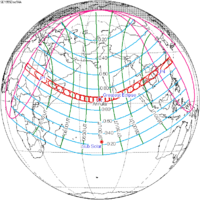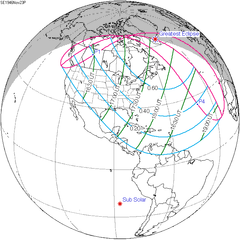| Partial eclipse | |||||||||||||
 The Moon's hourly motion shown right to left The Moon's hourly motion shown right to left | |||||||||||||
| Date | November 29, 1955 | ||||||||||||
|---|---|---|---|---|---|---|---|---|---|---|---|---|---|
| Gamma | 0.9551 | ||||||||||||
| Magnitude | 0.1190 | ||||||||||||
| Saros cycle | 115 (54 of 72) | ||||||||||||
| Partiality | 74 minutes, 10 seconds | ||||||||||||
| Penumbral | 253 minutes, 0 seconds | ||||||||||||
| |||||||||||||
| ← June 1955May 1956 → | |||||||||||||
A partial lunar eclipse occurred at the Moon’s descending node of orbit on Tuesday, November 29, 1955, with an umbral magnitude of 0.1190. A lunar eclipse occurs when the Moon moves into the Earth's shadow, causing the Moon to be darkened. A partial lunar eclipse occurs when one part of the Moon is in the Earth's umbra, while the other part is in the Earth's penumbra. Unlike a solar eclipse, which can only be viewed from a relatively small area of the world, a lunar eclipse may be viewed from anywhere on the night side of Earth. Occurring only about 18.5 hours before perigee (on November 30, 1955, at 11:25 UTC), the Moon's apparent diameter was larger.
Visibility
The eclipse was completely visible over eastern Europe, Asia, and Australia, seen rising over Africa and western Europe and setting over the central Pacific Ocean and northwestern North America.
 
|
Eclipse details
Shown below is a table displaying details about this particular solar eclipse. It describes various parameters pertaining to this eclipse.
| Parameter | Value |
|---|---|
| Penumbral Magnitude | 1.09167 |
| Umbral Magnitude | 0.11899 |
| Gamma | 0.95514 |
| Sun Right Ascension | 16h19m25.1s |
| Sun Declination | -21°25'59.1" |
| Sun Semi-Diameter | 16'13.0" |
| Sun Equatorial Horizontal Parallax | 08.9" |
| Moon Right Ascension | 04h19m06.8s |
| Moon Declination | +22°24'16.1" |
| Moon Semi-Diameter | 16'40.3" |
| Moon Equatorial Horizontal Parallax | 1°01'11.3" |
| ΔT | 31.4 s |
Eclipse season
See also: Eclipse cycleThis eclipse is part of an eclipse season, a period, roughly every six months, when eclipses occur. Only two (or occasionally three) eclipse seasons occur each year, and each season lasts about 35 days and repeats just short of six months (173 days) later; thus two full eclipse seasons always occur each year. Either two or three eclipses happen each eclipse season. In the sequence below, each eclipse is separated by a fortnight.
| November 29 Descending node (full moon) |
December 14 Ascending node (new moon) |
|---|---|
 |

|
| Partial lunar eclipse Lunar Saros 115 |
Annular solar eclipse Solar Saros 141 |
Related eclipses
Eclipses in 1955
- A penumbral lunar eclipse on January 8.
- A penumbral lunar eclipse on June 5.
- A total solar eclipse on June 20.
- A partial lunar eclipse on November 29.
- An annular solar eclipse on December 14.
Metonic
- Preceded by: Lunar eclipse of February 11, 1952
- Followed by: Lunar eclipse of September 17, 1959
Tzolkinex
- Preceded by: Lunar eclipse of October 18, 1948
- Followed by: Lunar eclipse of January 9, 1963
Half-Saros
- Preceded by: Solar eclipse of November 23, 1946
- Followed by: Solar eclipse of December 4, 1964
Tritos
- Preceded by: Lunar eclipse of December 29, 1944
- Followed by: Lunar eclipse of October 29, 1966
Lunar Saros 115
- Preceded by: Lunar eclipse of November 18, 1937
- Followed by: Lunar eclipse of December 10, 1973
Inex
- Preceded by: Lunar eclipse of December 19, 1926
- Followed by: Lunar eclipse of November 8, 1984
Triad
- Preceded by: Lunar eclipse of January 28, 1869
- Followed by: Lunar eclipse of September 29, 2042
Lunar eclipses of 1955–1958
This eclipse is a member of a semester series. An eclipse in a semester series of lunar eclipses repeats approximately every 177 days and 4 hours (a semester) at alternating nodes of the Moon's orbit.
The penumbral lunar eclipse on January 8, 1955 occurs in the previous lunar year eclipse set, and the penumbral lunar eclipse on April 4, 1958 occurs in the next lunar year eclipse set.
| Lunar eclipse series sets from 1955 to 1958 | ||||||||
|---|---|---|---|---|---|---|---|---|
| Ascending node | Descending node | |||||||
| Saros | Date Viewing |
Type Chart |
Gamma | Saros | Date Viewing |
Type Chart |
Gamma | |
| 110 | 1955 Jun 05
|
Penumbral
|
−1.2384 | 115 | 1955 Nov 29
|
Partial
|
0.9551 | |
| 120 | 1956 May 24
|
Partial
|
−0.4726 | 125 | 1956 Nov 18
|
Total
|
0.2917 | |
| 130 | 1957 May 13
|
Total
|
0.3046 | 135 | 1957 Nov 07
|
Total
|
−0.4332 | |
| 140 | 1958 May 03
|
Partial
|
1.0188 | 145 | 1958 Oct 27
|
Penumbral
|
−1.1571 | |
Saros 115
This eclipse is a part of Saros series 115, repeating every 18 years, 11 days, and containing 72 events. The series started with a penumbral lunar eclipse on April 21, 1000. It contains partial eclipses from July 6, 1126 through September 30, 1270; total eclipses from October 11, 1288 through July 20, 1739; and a second set of partial eclipses from July 30, 1757 through February 13, 2082. The series ends at member 72 as a penumbral eclipse on June 13, 2280.
The longest duration of totality was produced by member 36 at 99 minutes, 47 seconds on May 15, 1631. All eclipses in this series occur at the Moon’s descending node of orbit.
| Greatest | First | |||
|---|---|---|---|---|
| The greatest eclipse of the series occurred on 1631 May 15, lasting 99 minutes, 47 seconds. | Penumbral | Partial | Total | Central |
| 1000 Apr 21 |
1126 Jul 06 |
1288 Oct 11 |
1541 Mar 12 | |
| Last | ||||
| Central | Total | Partial | Penumbral | |
| 1685 Jun 16 |
1739 Jul 20 |
2082 Feb 13 |
2280 Jun 13 | |
Eclipses are tabulated in three columns; every third eclipse in the same column is one exeligmos apart, so they all cast shadows over approximately the same parts of the Earth.
| Series members 46–67 occur between 1801 and 2200: | |||||
|---|---|---|---|---|---|
| 46 | 47 | 48 | |||
| 1811 Sep 02 | 1829 Sep 13 | 1847 Sep 24 | |||
| 49 | 50 | 51 | |||
| 1865 Oct 04 | 1883 Oct 16 | 1901 Oct 27 | |||

|

| ||||
| 52 | 53 | 54 | |||
| 1919 Nov 07 | 1937 Nov 18 | 1955 Nov 29 | |||

|

|

|

|

|

|
| 55 | 56 | 57 | |||
| 1973 Dec 10 | 1991 Dec 21 | 2009 Dec 31 | |||

|

|

|

|

|

|
| 58 | 59 | 60 | |||
| 2028 Jan 12 | 2046 Jan 22 | 2064 Feb 02 | |||

|

|

|

|
||
| 61 | 62 | 63 | |||
| 2082 Feb 13 | 2100 Feb 24 | 2118 Mar 07 | |||
| 64 | 65 | 66 | |||
| 2136 Mar 18 | 2154 Mar 29 | 2172 Apr 09 | |||
| 67 | |||||
| 2190 Apr 20 | |||||
Half-Saros cycle
A lunar eclipse will be preceded and followed by solar eclipses by 9 years and 5.5 days (a half saros). This lunar eclipse is related to two partial solar eclipses of Solar Saros 122.
| November 23, 1946 | December 4, 1964 |
|---|---|

|

|
See also
Notes
- "November 29–30, 1955 Partial Lunar Eclipse". timeanddate. Retrieved 23 December 2024.
- "Moon Distances for London, United Kingdom, England". timeanddate. Retrieved 23 December 2024.
- "Partial Lunar Eclipse of 1955 Nov 29" (PDF). NASA. Retrieved 23 December 2024.
- "Partial Lunar Eclipse of 1955 Nov 29". EclipseWise.com. Retrieved 23 December 2024.
- van Gent, R.H. "Solar- and Lunar-Eclipse Predictions from Antiquity to the Present". A Catalogue of Eclipse Cycles. Utrecht University. Retrieved 6 October 2018.
- "NASA - Catalog of Lunar Eclipses of Saros 115". eclipse.gsfc.nasa.gov.
- Listing of Eclipses of series 115
- Mathematical Astronomy Morsels, Jean Meeus, p.110, Chapter 18, The half-saros
External links
- 1955 Nov 29 chart Eclipse Predictions by Fred Espenak, NASA/GSFC


